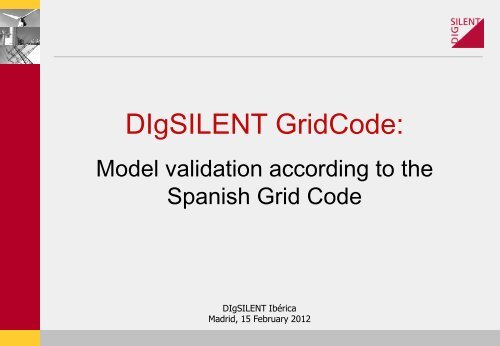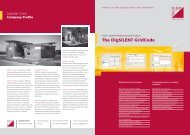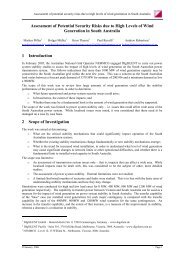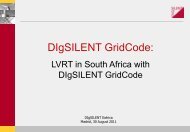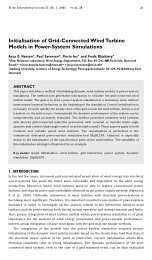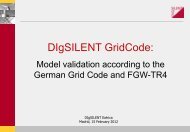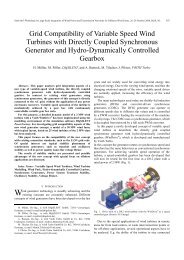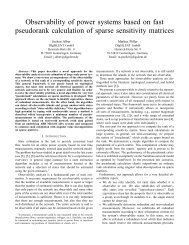Example of Model Validation according to the Spanish ... - DIgSILENT
Example of Model Validation according to the Spanish ... - DIgSILENT
Example of Model Validation according to the Spanish ... - DIgSILENT
You also want an ePaper? Increase the reach of your titles
YUMPU automatically turns print PDFs into web optimized ePapers that Google loves.
<strong>DIgSILENT</strong> GridCode:<br />
<strong>Model</strong> validation <strong>according</strong> <strong>to</strong> <strong>the</strong><br />
<strong>Spanish</strong> Grid Code<br />
<strong>DIgSILENT</strong> Ibérica<br />
Madrid, 15 February 2012
<strong>Model</strong> <strong>Validation</strong> <strong>according</strong> <strong>to</strong> <strong>the</strong> <strong>Spanish</strong> Grid Code<br />
New version Nr 10 <strong>of</strong> <strong>the</strong> <strong>Spanish</strong> Wind Energy Association document (PVVC_v10) is published in<br />
response <strong>to</strong> <strong>the</strong> revision <strong>of</strong> <strong>the</strong> <strong>Spanish</strong> Grid Code (P.O.12.3 and P.O.12.2):<br />
“PROCEDIMIENTOS DE VERIFICACIÓN, VALIDACIÓN Y CERTIFICACIÓN DE<br />
LOS REQUISITOS DEL P.O.12.3 SOBRE LA RESPUESTA DE LAS<br />
INSTALACIONES EÓLICAS Y FOTOVOLTAICAS ANTE HUECOS DE TENSIÓN”<br />
The document can be found at <strong>the</strong> <strong>Spanish</strong> Wind Energy Association website:<br />
http://www.aeeolica.org/<br />
<strong>DIgSILENT</strong> Ibérica S.L. 2
<strong>Model</strong> <strong>Validation</strong> <strong>according</strong> <strong>to</strong> <strong>the</strong> <strong>Spanish</strong> Grid Code<br />
Procedure for model validation PVVC_v10 (WIND TURBINES):<br />
- STEP 1: LVRT Field testing <strong>of</strong> <strong>the</strong> wind turbines <strong>according</strong> <strong>to</strong> <strong>the</strong> <strong>Spanish</strong> Grid Code and measurement procedures<br />
in <strong>the</strong> PVVC_v10. Measurements can be ei<strong>the</strong>r performed at <strong>the</strong> MV or LV side <strong>of</strong> <strong>the</strong> wind turbine.<br />
- STEP 2: The dynamic simulation model is built.<br />
- STEP 3: Simulations are executed reproducing <strong>the</strong> same events (voltage dips) performed during field testing.<br />
- STEP 4: Results obtained from every simulation case are compared against <strong>the</strong> corresponding field test<br />
measurements.<br />
- STEP 5: The validation method is based on <strong>the</strong> calculation <strong>of</strong> <strong>the</strong> absolute error:<br />
- Where:<br />
- Xmed: Field testing measurement data (in SI)<br />
- Xsim: Dynamic simulation data (in SI)<br />
- Xnom: Rated value <strong>of</strong> <strong>the</strong> compared variable (in SI)<br />
- Δx: Absolute Error (in %)<br />
- The model is validated when 85% <strong>of</strong> <strong>the</strong> calculated errors are below 10%.<br />
- Two variables are compared: Three phase active power (P), Three phase reactive power (Q)<br />
<strong>DIgSILENT</strong> Ibérica S.L. 3
<strong>Model</strong> <strong>Validation</strong> <strong>according</strong> <strong>to</strong> <strong>the</strong> <strong>Spanish</strong> Grid Code<br />
Some comments <strong>to</strong> <strong>the</strong> method:<br />
- Measurement data at LV side <strong>of</strong> <strong>the</strong> Wind Turbine are used for validation purposes. The voltage dip is performed<br />
at MV side.<br />
- The validation window is not specified. The PVVC_v10 document mentions <strong>the</strong> measurement window during field<br />
testing as:<br />
- 10 seconds prior <strong>to</strong> <strong>the</strong> voltage dip � <strong>to</strong>o long for validation purposes, it could have a positive impact on<br />
<strong>the</strong> validation results (more than 65% <strong>of</strong> data can be easily validated during steady state prior <strong>to</strong> <strong>the</strong> dip!).<br />
One second prior <strong>to</strong> <strong>the</strong> voltage dip is adequate <strong>to</strong> validate <strong>the</strong> correct initialization <strong>of</strong> <strong>the</strong> model, as<br />
proposed in <strong>the</strong> new draft <strong>of</strong> <strong>the</strong> IEC61400-27.<br />
- 5 seconds after <strong>the</strong> voltage recovery � ok.<br />
- Three phase dips and two phase dips are required in <strong>the</strong> <strong>Spanish</strong> Grid Code. Fundamental-frequency positive and<br />
negative sequence <strong>of</strong> simulation and field data is used for error calculation. The positive and negative sequence is<br />
calculated <strong>according</strong> <strong>to</strong> <strong>the</strong> IEC61400-21 Ed2.<br />
- More variables need <strong>to</strong> be compared in addition <strong>to</strong> <strong>the</strong> active and reactive power <strong>of</strong> <strong>the</strong> wind turbine. The<br />
variables proposed in <strong>the</strong> IEC61400-27 will be evaluated in this example:<br />
- Wind turbine active current (Ip in p.u.)<br />
- Wind turbine reactive current (Iq in p.u.)<br />
- Wind turbine terminal voltage (V in p.u.)<br />
- Wind turbine Reactive power (Q in p.u.)<br />
- Wind turbine Active power (P in p.u.)<br />
- Resampling is used when measured values and simulation values are sampled at different rates.<br />
- A low pass filter with a cut <strong>of</strong>f frequency <strong>of</strong> 15Hz is included in this analysis, as proposed in <strong>the</strong> IEC61400-27 (<strong>to</strong><br />
compare <strong>the</strong> same bandwidth simulation-measurements).<br />
<strong>DIgSILENT</strong> Ibérica S.L. 4
<strong>Example</strong> <strong>of</strong> <strong>Model</strong> <strong>Validation</strong> <strong>according</strong> <strong>to</strong> <strong>the</strong> <strong>Spanish</strong> Grid Code<br />
STEP 1: Building <strong>the</strong> example <strong>to</strong> test <strong>the</strong> <strong>Spanish</strong> Case: DFIG model against FC model<br />
To avoid using field measurements <strong>to</strong> illustrate <strong>the</strong> <strong>Spanish</strong> method, <strong>the</strong> behavior <strong>of</strong> <strong>the</strong> dynamic model <strong>of</strong> a<br />
Doubly Fed Induction Genera<strong>to</strong>r (DFIG) is validated against <strong>the</strong> dynamic model <strong>of</strong> a Full Converter (FC) wind<br />
turbine. The following example is built in <strong>DIgSILENT</strong> PowerFac<strong>to</strong>ry 14.1.2 (x86). The project includes two wind<br />
turbine models from <strong>the</strong> <strong>DIgSILENT</strong> PowerFac<strong>to</strong>ry global library templates:<br />
-1xDFIG, rated 2MW<br />
- DFIG WT transformer 400V/20kV, rated 2.22MVA<br />
- 1xFC, rated 2MW<br />
- FC WT transformer 400V/20kV, rated 2.3 MVA<br />
- The PCC is rated 110kV<br />
- The substation transformer is rated 80MVA, 110/20kV<br />
<strong>DIgSILENT</strong> Ibérica S.L. 5
<strong>Example</strong> <strong>of</strong> <strong>Model</strong> <strong>Validation</strong> <strong>according</strong> <strong>to</strong> <strong>the</strong> <strong>Spanish</strong> Grid Code<br />
STEP 2: Simulation <strong>of</strong> LVRT events <strong>according</strong> <strong>to</strong> <strong>the</strong> <strong>Spanish</strong> Grid Code:<br />
RMS simulation - 1kHz time step<br />
Tinit = 0s, Tend = 6.5s, Tdip init = 1s, Tdip end = 1.5s<br />
Filtering RMS results (low pass filter, cut <strong>of</strong>f 15Hz) + Conversion <strong>to</strong> 50Hz � export signals<br />
Voltage dip location: at <strong>the</strong> Wind Farm MV terminal, 20kV side<br />
Voltage dip measurements: at <strong>the</strong> LV side <strong>of</strong> <strong>the</strong> wind turbines<br />
<strong>DIgSILENT</strong> Ibérica S.L. 6
<strong>Example</strong> <strong>of</strong> <strong>Model</strong> <strong>Validation</strong> <strong>according</strong> <strong>to</strong> <strong>the</strong> <strong>Spanish</strong> Grid Code<br />
STEP 2: Simulation <strong>of</strong> LVRT events <strong>according</strong> <strong>to</strong> <strong>the</strong> <strong>Spanish</strong> Grid Code:<br />
The field and simulation tests are included in <strong>the</strong> PVVC procedure:<br />
-Voltage dip prefault loading level <strong>of</strong> <strong>the</strong> wind turbines:<br />
-Partial load � 10-30%, cos φ � 0.9i- 0.95c<br />
-Full load � >80%, cos φ � 0.9i- 0.95c<br />
-Type <strong>of</strong> Voltage dip and loading level:<br />
-Category I and II � three phase voltage dips at partial and full load respectively<br />
-Category III and IV � two phase voltage dips at partial and full load respectively<br />
-Voltage depth, duration, <strong>to</strong>lerances:<br />
- Three phase dips � remaining voltage 20% + 3% Urated, during ≥450ms<br />
- Two phase dips � remaining voltage 60% + 10% Urated, during ≥450ms<br />
<strong>DIgSILENT</strong> Ibérica S.L. 7
HV<br />
MV<br />
LV_FC<br />
Trf_ST Trf_ST<br />
Trf_FC Trf_FC<br />
AC Voltag..<br />
V ~<br />
FC 2MW<br />
<strong>Example</strong> <strong>of</strong> <strong>Model</strong> <strong>Validation</strong> <strong>according</strong> <strong>to</strong> <strong>the</strong> <strong>Spanish</strong> Grid Code<br />
STEP 3: Export required signals from VIs in <strong>DIgSILENT</strong> PowerFac<strong>to</strong>ry:<br />
LV_DFIG<br />
Trf_DFIG Trf_DFIG<br />
G ~<br />
DFIG_2MW<br />
Three phase dip at MV side, 20% remaining voltage, 500ms<br />
Ua(t), Ub(t), Uc(t) � Volts<br />
Ia(t), Ib(t), Ic(t) � Amps<br />
Textfile, white space/tab separated format<br />
VOLTAGE AND CURRENT<br />
MEASUREMENTS<br />
7500.0<br />
4500.0<br />
1500.0<br />
-1500.0<br />
-4500.0<br />
-7500.0<br />
0.0000 1.2999<br />
2.5998<br />
3.8997<br />
5.1996<br />
[s]<br />
Conversion DFIG: UA<br />
Conversion DFIG: UB<br />
Conversion DFIG: UC<br />
Conversion DFIG: IA<br />
Conversion DFIG: IB<br />
Conversion DFIG: IC<br />
Voltage dip 20% - DFIG<br />
6.4995<br />
<strong>DIgSILENT</strong><br />
<strong>DIgSILENT</strong><br />
7500.0<br />
4500.0<br />
1500.0<br />
-1500.0<br />
-4500.0<br />
-7500.0<br />
0.0000 1.0998<br />
2.1997<br />
3.2995<br />
4.3993<br />
[s]<br />
<strong>DIgSILENT</strong> Ibérica S.L. 8<br />
Conversion FC: UA<br />
Conversion FC: UB<br />
Conversion FC: UC<br />
Conversion FC: IA<br />
Conversion FC: IB<br />
Conversion FC: IC<br />
Voltage dip 20% - FC<br />
5.4992<br />
<strong>DIgSILENT</strong>
<strong>Example</strong> <strong>of</strong> <strong>Model</strong> <strong>Validation</strong> <strong>according</strong> <strong>to</strong> <strong>the</strong> <strong>Spanish</strong> Grid Code<br />
STEP 4: Analysis with <strong>DIgSILENT</strong> GridCode � MODEL VALIDATION TOOL<br />
Default window:<br />
<strong>DIgSILENT</strong> Ibérica S.L. 9
<strong>Example</strong> <strong>of</strong> <strong>Model</strong> <strong>Validation</strong> <strong>according</strong> <strong>to</strong> <strong>the</strong> <strong>Spanish</strong> Grid Code<br />
STEP 4: Analysis with <strong>DIgSILENT</strong> GridCode � MODEL VALIDATION TOOL<br />
STEP 4.1: File Types & Channels Edi<strong>to</strong>r � Create File Type <strong>to</strong> read <strong>DIgSILENT</strong> PowerFac<strong>to</strong>ry<br />
exported results.<br />
<strong>DIgSILENT</strong> Ibérica S.L. 10
<strong>Example</strong> <strong>of</strong> <strong>Model</strong> <strong>Validation</strong> <strong>according</strong> <strong>to</strong> <strong>the</strong> <strong>Spanish</strong> Grid Code<br />
STEP 4: Analysis with <strong>DIgSILENT</strong> GridCode � MODEL VALIDATION TOOL<br />
STEP 4.1: File Types & Channels Edi<strong>to</strong>r<br />
STEP 4.2: Open file 1 and 2 <strong>to</strong> compare, select file format and base values.<br />
Select file 1<br />
Select file format<br />
<strong>DIgSILENT</strong> Ibérica S.L. 11
<strong>Example</strong> <strong>of</strong> <strong>Model</strong> <strong>Validation</strong> <strong>according</strong> <strong>to</strong> <strong>the</strong> <strong>Spanish</strong> Grid Code<br />
STEP 4: Analysis with <strong>DIgSILENT</strong> GridCode � MODEL VALIDATION TOOL<br />
STEP 4.1: File Types & Channels Edi<strong>to</strong>r<br />
STEP 4.2: Open file 1 and 2 <strong>to</strong> compare, select file format and base values.<br />
Select<br />
base values<br />
for FC and DFIG<br />
<strong>DIgSILENT</strong> Ibérica S.L. 12
<strong>Example</strong> <strong>of</strong> <strong>Model</strong> <strong>Validation</strong> <strong>according</strong> <strong>to</strong> <strong>the</strong> <strong>Spanish</strong> Grid Code<br />
STEP 4: Analysis with <strong>DIgSILENT</strong> GridCode � MODEL VALIDATION TOOL<br />
STEP 4.1: File Types & Channels Edi<strong>to</strong>r<br />
STEP 4.2: Open file 1 and 2 <strong>to</strong> compare, select file format and base values.<br />
STEP 4.3: Select <strong>Spanish</strong> method and variables <strong>to</strong> compare. Click “Synchronize and Compare”.<br />
Absolute errors<br />
Select variables<br />
<strong>to</strong> compare<br />
GO!<br />
<strong>DIgSILENT</strong> Ibérica S.L. 13
Select reference<br />
variable for<br />
synchronization<br />
<strong>Example</strong> <strong>of</strong> <strong>Model</strong> <strong>Validation</strong> <strong>according</strong> <strong>to</strong> <strong>the</strong> <strong>Spanish</strong> Grid Code<br />
STEP 4: Analysis with <strong>DIgSILENT</strong> GridCode � MODEL VALIDATION TOOL<br />
STEP 4.1: File Types & Channels Edi<strong>to</strong>r<br />
STEP 4.2: Open file 1 and 2 <strong>to</strong> compare, select file format and base values.<br />
STEP 4.3: Select <strong>Spanish</strong> method and variables <strong>to</strong> compare. Click “Synchronize and Compare”.<br />
STEP 4.4: Manual synchronization series 1 and 2.<br />
Use scroll bars <strong>to</strong><br />
synchronize both<br />
data series<br />
<strong>DIgSILENT</strong> Ibérica S.L. 14
<strong>Example</strong> <strong>of</strong> <strong>Model</strong> <strong>Validation</strong> <strong>according</strong> <strong>to</strong> <strong>the</strong> <strong>Spanish</strong> Grid Code<br />
STEP 5: Analysis <strong>of</strong> results� Summary <strong>of</strong> results is reported in table format<br />
Variable<br />
Percentile 85<br />
(p.u.)<br />
Error Max<br />
(p.u.)<br />
Error Avg<br />
(p.u.)<br />
volts:abs:pos [pu] 0.000 0.226 0.002<br />
power:real:pos [pu] 0.046 0.407 0.026<br />
power:real:ABC [pu] 0.046 0.247 0.025<br />
power:reactive:pos [pu] 0.005 0.676 0.011<br />
power:reactive:ABC [pu] 0.005 0.615 0.011<br />
amps:real:pos [pu] 0.046 0.736 0.049<br />
amps:reactive:pos [pu] 0.006 1.343 0.025<br />
<strong>DIgSILENT</strong> Ibérica S.L. 15
<strong>Example</strong> <strong>of</strong> <strong>Model</strong> <strong>Validation</strong> <strong>according</strong> <strong>to</strong> <strong>the</strong> <strong>Spanish</strong> Grid Code<br />
STEP 5: Analysis <strong>of</strong> results� Graphs are reported <strong>according</strong> <strong>to</strong> <strong>the</strong> PVVC_v10<br />
STEP 5.1: <strong>Example</strong>, three phase active power (power:real:ABC)<br />
BLUE � The reference variable is <strong>the</strong> FC active power ABC.<br />
BLACK � A <strong>to</strong>lerance band is added <strong>to</strong> <strong>the</strong> reference variable (±10%).<br />
RED � The DFIG active power ABC.<br />
Graphically, <strong>the</strong> user can check if most <strong>of</strong> <strong>the</strong> samples in both data<br />
series fit within <strong>the</strong> <strong>to</strong>lerance band.<br />
The plot shows that 85% <strong>of</strong> compared samples are below <strong>the</strong> maximum<br />
error level (10%) � validation criteria is fulfilled<br />
<strong>DIgSILENT</strong> Ibérica S.L. 16
<strong>Example</strong> <strong>of</strong> <strong>Model</strong> <strong>Validation</strong> <strong>according</strong> <strong>to</strong> <strong>the</strong> <strong>Spanish</strong> Grid Code<br />
STEP 5: Analysis <strong>of</strong> results� Graphs are reported <strong>according</strong> <strong>to</strong> <strong>the</strong> PVVC_v10<br />
STEP 5.1: <strong>Example</strong>, three phase active power (power:real:ABC)<br />
STEP 5.2: <strong>Example</strong>, three phase reactive power (power:reactive:ABC)<br />
BLUE � The reference variable is <strong>the</strong> FC reactive power ABC.<br />
BLACK � A <strong>to</strong>lerance band is added <strong>to</strong> <strong>the</strong> reference variable (±10%).<br />
RED � The DFIG reactive power ABC.<br />
Graphically, <strong>the</strong> user can check if most <strong>of</strong> <strong>the</strong> samples in both data<br />
series fit within <strong>the</strong> <strong>to</strong>lerance band.<br />
The plot shows that 85% <strong>of</strong> compared samples are below <strong>the</strong> maximum<br />
error level (10%) � validation criteria is fulfilled<br />
<strong>DIgSILENT</strong> Ibérica S.L. 17
<strong>Example</strong> <strong>of</strong> <strong>Model</strong> <strong>Validation</strong> <strong>according</strong> <strong>to</strong> <strong>the</strong> <strong>Spanish</strong> Grid Code<br />
STEP 5: Analysis <strong>of</strong> results� Graphs are reported <strong>according</strong> <strong>to</strong> <strong>the</strong> PVVC_v10<br />
STEP 5.1: <strong>Example</strong>, three phase active power (power:real:ABC)<br />
STEP 5.2: <strong>Example</strong>, three phase reactive power (power:reactive:ABC)<br />
STEP 5.3: More variables can be observed:<br />
Fund. Freq. positive sequence active current (Ip+) � Ok Fund. Freq. positive sequence active power (P+) �Ok<br />
<strong>DIgSILENT</strong> Ibérica S.L. 18
<strong>Example</strong> <strong>of</strong> <strong>Model</strong> <strong>Validation</strong> <strong>according</strong> <strong>to</strong> <strong>the</strong> <strong>Spanish</strong> Grid Code<br />
STEP 5: Analysis <strong>of</strong> results� Graphs are reported <strong>according</strong> <strong>to</strong> <strong>the</strong> PVVC_v10<br />
STEP 5.1: <strong>Example</strong>, three phase active power (power:real:ABC)<br />
STEP 5.2: <strong>Example</strong>, three phase reactive power (power:reactive:ABC)<br />
STEP 5.3: More variables can be observed:<br />
Fund. Freq. positive sequence reactive current (Iq+) � Ok Fund. Freq. positive sequence reactive power (Q+) �Ok<br />
<strong>DIgSILENT</strong> Ibérica S.L. 19
<strong>Example</strong> <strong>of</strong> <strong>Model</strong> <strong>Validation</strong> <strong>according</strong> <strong>to</strong> <strong>the</strong> <strong>Spanish</strong> Grid Code<br />
REPORTING<br />
Results are reported in Word format.<br />
<strong>DIgSILENT</strong> Ibérica S.L. 20
<strong>Example</strong> <strong>of</strong> <strong>Model</strong> <strong>Validation</strong> <strong>according</strong> <strong>to</strong> <strong>the</strong> <strong>Spanish</strong> Grid Code<br />
CONCLUSIONS<br />
The <strong>Spanish</strong> Method as proposed in <strong>the</strong> PVVC_v10 is verified with <strong>DIgSILENT</strong> GridCode, comparing<br />
two wind turbine models that separately can fulfill <strong>the</strong> requirements <strong>of</strong> <strong>the</strong> <strong>Spanish</strong> Grid Code<br />
(P.O.12.3). The following conclusions can be drawn:<br />
- The <strong>DIgSILENT</strong> GridCode <strong>to</strong>ol is very flexible:<br />
- Different file formats can be configured<br />
- Different data series can be compared<br />
- The user can define <strong>the</strong> variables <strong>of</strong> interest � <strong>the</strong> report au<strong>to</strong>matically will include <strong>the</strong><br />
variables selected by <strong>the</strong> user<br />
- Manual synchronization is a good approach <strong>to</strong> overlap both series.<br />
- A report is au<strong>to</strong>matically generated in Micros<strong>of</strong>t Word© format.<br />
- More validation methods are rising worldwide and will be included in next versions:<br />
- German validation method <strong>according</strong> <strong>to</strong> TR4<br />
- IEC61400-27 validation method<br />
<strong>DIgSILENT</strong> Ibérica S.L. 21
<strong>DIgSILENT</strong> GridCode Contact<br />
Ana Morales/Xavier Robe<br />
<strong>DIgSILENT</strong> Ibérica S.L.<br />
Ribera del Loira, 46<br />
28042 Madrid – Spain<br />
Phone: +34 911273723/24<br />
Email:<br />
a.morales@digsilent.com<br />
x.robe@digsilent.com<br />
Website:<br />
www.digsilent.com<br />
22


